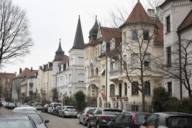
The Neuhausen district unites many contrasting facets: It has places that rank among Munich's most famous sights, as well as the directly adjacent streets that are usually overlooked by visitors. A pity, really. Neuhausen's streets around Rotkreuzplatz (square) are home to lovely shops, cafés and restaurants, for example in Volkartstrasse. About the charm of a city district that is more diverse than any other.
Neuhausen or, as it is correctly called, Neuhausen-Nymphenburg, offers a multiple-personality experience. Within a few minutes' walk, you can switch from one scenario to a completely different one. In addition to Schloss Nymphenburg (palace), parks, beer gardens, villas and residential areas, you will also encounter industry and busy streets. This makes the neighbourhood a miniature version of the entire city: a kind of mini-Munich.
She named the palace after her favourite fairy-tale creatures, the nymphs.
The diversity of Neuhausen-Nymphenburg can be attributed to its history. It was once a small, insignificant village in the north-west of Munich, but an event in 1664 left its mark on the neighbourhood until this day: To celebrate the birth of the Bavarian heir to the throne, Max Emanuel, his parents, the electoral couple Ferdinand Maria and Henriette Adelaide von Savoyen, had a summer residence built, modelled on Italian country houses from the electress's homeland. She named the palace after her favourite fairy-tale creatures, the nymphs. Many of these mystical spirits are immortalised on the ceiling paintings in the electress's apartments.
The palace is a typical example of Baroque architecture: characterised by strict order and symmetry. However, it also represents state of the art architecture of the time. Since the nobles wanted to escape the confines and darkness of the city, the façades of the building had to accommodate the maximum number of windows.
Until today, this remains a striking feature. In the evening, the setting sun shines through the huge arched windows in the central wing from the park side, imparting the palace a magical transparency. Visitors definitely do not have to resort to psychedelic substances to be mesmerised by this spectacle of light.
The real sensation of the neighbourhood, which is known far beyond the boarders of Neuhausen, Munich and even Germany, is actually the Schlosspark. Not only is it Munich's largest park, but it also offers a wealth of insights into the history of horticulture.
Originally, in the early 18th century, it was laid out as a baroque garden: nature was tamed with flat, strictly symmetrical borders next to gravel paths and all visual axes leading to the centre of power: the absolutist ruler and his palace. The adjacent landscape park, which was created at the beginning of the 19th century, is a stark contrast – a dense, natural mixed forest, beautifully complemented by meadows and lakes. The perfect place to get lost in dreams.
The Wittelsbach dynasty's summer residence influenced the new neighbourhood – far beyond the actual palace grounds. To keep the lords entertained, a hunting area was laid out in the immediate vicinity of the palace. This was the origin of the Taxisgarten (where the roaming pheasants served as targets) and, most notably, Hirschgarten, where the gamekeeper was allowed to serve beer as early as 1791 – 20 years before the first Bavarian beer gardens. Especially on summer days, this is one of the main reasons why large crowds flock here from the city.
In Bavaria, hedonism thus forged a strong link between the ruling classes and the people.
Over the following decades, the neighbourhood earned a reputation as an entertainment district. Countless restaurants and pubs emerged around the palace. Until the outbreak of the First World War, it was the home of the “Volksgarten“, a kind of permanent Oktoberfest, which, today, can only be recognised by the name of ‘Volksgartenstrasse’.
In the 19th century, numerous exclusive residential areas were built near the palace – it was considered chic to live in the immediate vicinity of the Wittelsbach summer residence. Around the same time, however, barracks, factories and breweries were also built in Neuhausen-Nymphenburg, as Munich was bursting at the seams when industrialisation started. The expansion of the Mittlerer Ring highway in 1972 was another major milestone.
Since then, the Neuhausen district has been what it is: often confusing for outsiders with its compartmentalisation, which today could be described as diversity. However, this is precisely why the neighbourhood is so popular with its locals.
If it were not for the major attractions – the Schloss Nymphenburg, the Botanical Gardens, the Hirschgarten and the Herz-Jesu-Kirche (church) – not many non-Neuhausen residents would bother to come here. One exception is the ‘Krankenhaus des Dritten Ordens’, which is known as one of the best maternity hospitals in the world – but, of course, people usually only visit such an institution one or two times in a lifetime.
The neighbourhood’s unique seclusion – geographically seen, it is actually quite central, yet still somewhat off the beaten track – gives it a very special atmosphere. Occasionally, it has an almost village-like identity and boasts particularly lovely shops, cafés and restaurants in the streets around Rotkreutzplatz, such as Volkartstrasse.
Neuhausen locals are also proud of the Sarcletti ice cream parlour, which has been known for its Tuscan quality ice cream since 1879, decades before the general Italomania trend. Another local favourite is the Ruffini (the neighbourhood is fond of Italian names), an alternative confectionery known for its left-wing ethos and self-management model, practising what is called “sugary communis“ since 1978. The community is pleased when these establishments become known beyond Neuhausen, but even more pleased that this is an exception – and that Munich here is “so normal“, so unpretentious.